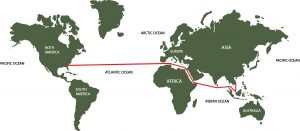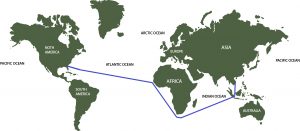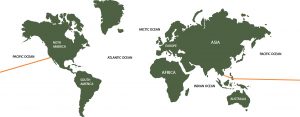Sea shipping is one of the most important international modes of transportation in Vietnam, US, and all over the world. According to the statistics of the United Nations Conference on Trade and Development (UNCTAD), around 80% of the volume of international goods transportation is carried by sea, and the proportion is even higher for many developing countries. If you are working in the import-export field, especially between Vietnam and the US, it is very crucial to read this newsletter. Noble Network would like to provide you with helpful information about sea shipping from Vietnam to the US, including: main sea shipping routes (advantages and disadvantages), estimated arrival time, and costs.
1. Main sea shipping routes from Vietnam to the US
a. Route through the Suez Canal
Starting from Vietnam, the ships pass through the Singapore Strait, Malacca Strait, divert to the South of Sri Lanka in the Indian Ocean, enter the Red Sea, pass through the Suez Canal, sail through the Mediterranean Sea, cross the Gibraltar Strait, and finally cross the Atlantic Ocean to the US and vice versa.

Advantages:
This route passes quite close to the shore during much of the way, so response to adverse incidents can be quite convenient. Further, if the sailing date is during November to March, ships can take advantage of the east-to-west currents to increase speed between Vietnam to Singapore and again through the Strait of Malacca to the Suez Canal. It should also be noted that the current reverses direction from West to East during the months of May to September. The Northern Hemisphere Atlantic current always tends to flow in a clockwise direction, including a south-western route from the Strait of Gibraltar to Central America. It can be taken advantage of year round to speed west-traveling ships.
Disadvantages:
This route runs through areas with a high density of ships such as Singapore Strait, Malacca, and Suez Canal. The cost of the Suez Canal is quite high. The overall distance is longer than the Pacific Ocean route. Also vessels on the Arabian Gulf region route encounter strong winds of up to level 7 causing wave heights of 3-4 meters with lots of foam and water spray for more than 10 days per month during June to September. Further, from June to September it is often cloudy and rainy in the North Indian Ocean due to the influence of the southwest monsoons. Finally, when crossing the Atlantic, ships must run at high latitudes and this sea often threatens big storms. Therefore, caution should be exercised when navigating during the stormy season.
b. Route through the the Cape of Good Hope
From Vietnam, ships divert straight to Indonesia, cross the Jakarta Strait, cross the Indian Ocean to the Cape of Good Hope (in South Africa), then continue across the Atlantic to the US and vice versa.

Advantages:
The density of boats along this route is quite sparse. Ships don’t have to go through the Suez Canal, so costs are reduced. Southern Hemisphere currents are taken advantage of to improve ship speed. The direction of flow always tends to flow from East to West.
Disadvantages:
This is the longest ship running distance out of the 3 routes. The ship often runs very far from shore, so when there is an incident, it is comparatively difficult to get support. The ship runs down to the Cape of Good Hope, an area with very high latitudes and very complicated weather conditions. The Cape of Good Hope area regularly experiences strong waves and winds most times of the year, and often develops unusual storms and cyclones. Since this route is typically far from shore, calling at ports for fuel requires significant deviations and there are few fueling port options, especially on the legs that cross the Indian Ocean and the Atlantic Ocean.
c. Route through the Pacific Ocean
From Vietnam, ships run to the East, through the Philippines, across the Pacific Ocean to arrive in the US.

Advantages:
This route is the shortest of the 3 routes. Navigational conditions are somewhat simpler, no need to use many detailed charts. The ship can run along the equator at 5 degrees north latitude, which is an area with very stable and good weather conditions most days of the year.
Disadvantages:
There are no ports to call in case of an accident or if in need of fuel or supplies along the way, so the trip requires good preparation, current machinery maintenance, and ample fuel and supplies reserves.
⇒ Recommendations:
–  In fact, all three routes above are regularly used by ships to and from Vietnam, but only large ships with a tonnage of 15,000 DWT or more can make such long trips, because of costs, safety, and the required fuel and fresh water reserves for the journey.
– Â Based on the experience of the people working in the logistics field, the route through the Pacific Ocean brings the highest economical benefits, and the weather along this route is also usually good and stable. It also provides quick access to southern and eastern US ports once the ship passes through the Panama Canal south of the US in Central America.
2. Estimated arrival time of sea shipping from Vietnam to the US
Container shipping time for sea routes from Vietnam to the US is quite long, it takes from 30-45 days depending on the destination port (Los Angeles, Long Beach, New York & New Jersey, Georgia, Virginia, Houston, South Carolina, Oakland, Miami,…)

The arrival time also depends a lot on destinations/departures (port vs. inland city centers or countrysides), holidays (the shippers have day-offs), weather conditions, types of goods (Some special goods, or restricted goods will experience longer shipping times because they require satisfying supplemental procedures such as: quarantine, inspection, provision of import and export customs documents, etc.).Â
3. Estimated costs of sea shipping from Vietnam to the US
The costs of sea shipping from Vietnam to the US are diverse based on the delivery speed (fast or economical), taxes, types of goods, service fees, freight agency, and container load.

Now, due to the pandemic of COVID-19, the sea shipping services have been negatively influenced, making the costs vary significantly and frequently over time. Lately, many ships have arrived at their destination and been unable to unload their cargo without substantial delays, sometimes due to COVID-19 effects on labor, and sometimes due to large international imbalances in trade demand. As a result, currently there is an inadequate supply of containers and ships at departure ports, and excessive inventory of containers and ships at destination ports. The excess supply at destination ports has reduced costs significantly for return direction shipments and rocketed cost from traditional departure ports. In fact, the need to return containers to departure ports is so high that shipping companies are now funding returning shiploads of empty containers in order to meet export demand. In many cases this imbalance has created cost-savings opportunities for companies wishing to transport goods by sea to high-demand departure ports. However, the high accumulation of containers in arrival ports has also created the unintended consequences of increased shipping costs from traditional departure ports to offset the empty container return costs. And as a strange twist of fate, now companies wishing to rent containers to ship in the return direction are competing with the demand by shipping companies wishing to ship empty containers to traditional destination ports. Yes—It’s complicated.
As a result, you must complete careful and detailed research before choosing the logistics agency, destination port, and departure port. Thanks to the experience of our Noble Network team, we are happy to help our Members and clients address this challenge. Come join us so together we can build your most profitable trade project!

 Tiếng Việt
Tiếng Việt